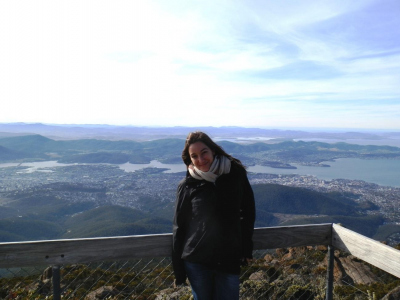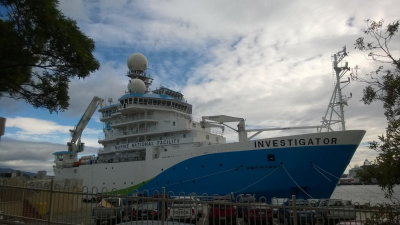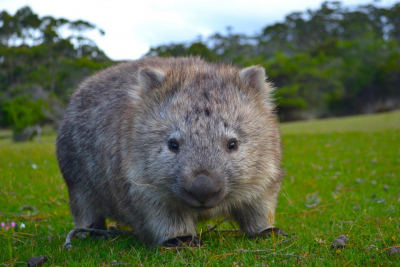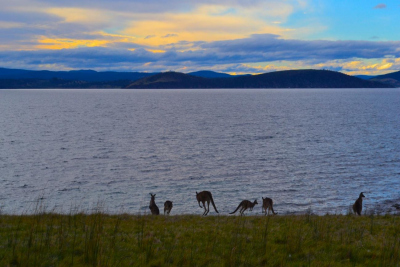Die Inhalte dieser Seite sind leider nicht auf Deutsch verfügbar.
Seitenpfad:
- Graduate School GLOMAR
- PhD student reports
- Research Placements
- Sara Minarro
Sara Minarro
Report of GLOMAR PhD student Sara Minarro about her research stay at the CSIRO Marine and Atmospheric Research branch in Hobart, Tasmania from 5 January – 27 May 2015
I was a guest at the CSIRO Marine and Atmospheric Research branch in Hobart, the main city of Tasmania, for five months earlier this year doing my research stay as part of the GLOMAR curriculum. I was based at the department of Marine Ecosystems Modelling visiting Ingrid van Putten, an economist who works on integrating human behaviour in ecosystem models, and Beth Fulton, a renowned expert in marine ecosystems modelling who has created widely used models for management of marine resources like Atlantis or InVitro.
In my doctoral study, I am developing an ecosystem model to represent coral reef dynamics under multiple stressors and human use scenarios, with the case study of the Spermonde Archipelago in Indonesia. It is aimed at becoming a decision-support tool for local managers to explore the likely ecological consequences of different management settings. The purpose of my research stay was two-fold. First, I was seeking to get input and feedback on technical aspects to improve my model, drawing on their in-house skills and experience. Dr Fulton’s expertise on models tackling marine ecosystems and their management, including modelling of coral reefs in the Indo-Pacific, was noticeable in her suggestions on missing links and the general assumptions made in the model, on optimizing the computer program, and advice on best ways to present its results. Second, I analysed socio-economic data about the Spermonde fishery in order to understand the drivers of fishing behaviour. Dr. van Putten helped me analyse the data in a meaningful way, and my work there is the foundation of my first PhD manuscript. The paper looks at linking socio-economic variables with fishers’ return from fishing, and I intend to incorporate some of the findings in the fishing pressure module of my model.
While at CSIRO, I had the chance to attend the “Structure and Function of Marine Ecosystems” course which was part of the Quantitative Marine Science PhD program and had a focus on the modelling approaches used to study the structure, functioning and dynamics of marine ecosystems. Needless to say, this was a substantial boost to my modelling skills and background knowledge. Furthermore, my location in the modelling team gave me access to a number of scientists and graduate students who were familiar with developing ecological and fisheries models. Finally, a side advantage of spending an extended period of time in Tasmania allowed me to get to know this amazing island through weekend trips, which was a memorable experience.
I would like to thank GLOMAR for its generous support, as well as my hosts Dr. Beth Fulton and Dr. Ingrid van Putten. It was a remarkable experience both personally and professionally, and an important contribution to advancing my PhD work.
In my doctoral study, I am developing an ecosystem model to represent coral reef dynamics under multiple stressors and human use scenarios, with the case study of the Spermonde Archipelago in Indonesia. It is aimed at becoming a decision-support tool for local managers to explore the likely ecological consequences of different management settings. The purpose of my research stay was two-fold. First, I was seeking to get input and feedback on technical aspects to improve my model, drawing on their in-house skills and experience. Dr Fulton’s expertise on models tackling marine ecosystems and their management, including modelling of coral reefs in the Indo-Pacific, was noticeable in her suggestions on missing links and the general assumptions made in the model, on optimizing the computer program, and advice on best ways to present its results. Second, I analysed socio-economic data about the Spermonde fishery in order to understand the drivers of fishing behaviour. Dr. van Putten helped me analyse the data in a meaningful way, and my work there is the foundation of my first PhD manuscript. The paper looks at linking socio-economic variables with fishers’ return from fishing, and I intend to incorporate some of the findings in the fishing pressure module of my model.
While at CSIRO, I had the chance to attend the “Structure and Function of Marine Ecosystems” course which was part of the Quantitative Marine Science PhD program and had a focus on the modelling approaches used to study the structure, functioning and dynamics of marine ecosystems. Needless to say, this was a substantial boost to my modelling skills and background knowledge. Furthermore, my location in the modelling team gave me access to a number of scientists and graduate students who were familiar with developing ecological and fisheries models. Finally, a side advantage of spending an extended period of time in Tasmania allowed me to get to know this amazing island through weekend trips, which was a memorable experience.
I would like to thank GLOMAR for its generous support, as well as my hosts Dr. Beth Fulton and Dr. Ingrid van Putten. It was a remarkable experience both personally and professionally, and an important contribution to advancing my PhD work.






